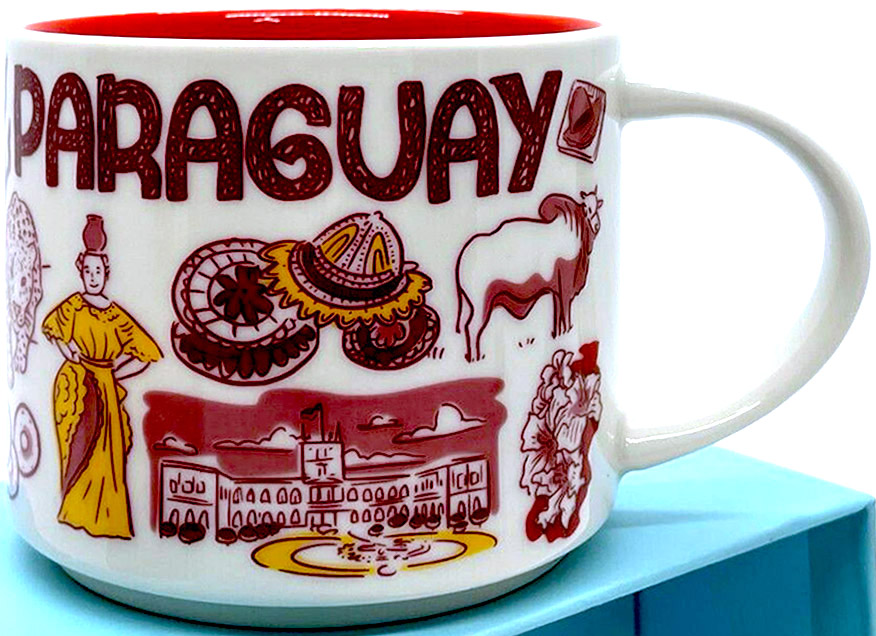
Been There – Paraguay
Here is a release for a landlocked country in South America, Starbucks Been There – Paraguay mug. This country boasts a rich history and culture. One of its most remarkable historical periods was under the rule of the indigenous Guaraní people, who cultivated a vibrant society long before the arrival of Spanish explorers in the 16th century. The Spanish colonization of Paraguay began in 1537, leading to centuries of struggle for independence and sovereignty. Notably, Paraguay gained its independence from Spain in 1811, marking the start of a tumultuous yet resilient journey as a sovereign nation. Throughout its history, Paraguay faced numerous challenges, however, it persevered, shaping a unique national identity influenced by its indigenous roots, Spanish heritage, and the resilience of its people.
Did you know that Paraguay stands unique among its South American neighbors with its designation of two official languages: Spanish and Guarani. Spanish serves as the predominant language in official documents, education, and business transactions, reflecting the country’s colonial history and modern ties with Spanish-speaking nations. Guarani, however, holds deep cultural and historical significance, spoken by the majority of the population and recognized as a symbol of indigenous identity and heritage. This dual linguistic heritage underscores Paraguay’s commitment to preserving its diverse cultural tapestry and fostering inclusivity within its society, where both languages coexist harmoniously in everyday life, reflecting the country’s rich linguistic and cultural diversity.
Here are some symbols and landmarks of “the heart of South America”:
– Ñandutí is a traditional Paraguayan lacework characterized by its intricate spiderweb-like patterns. Originating from the town of Itauguá, Ñandutí holds a special place in Paraguayan culture as a symbol of artistic heritage and craftsmanship. The delicate lacework is typically handcrafted using a needle and thread, creating intricate designs that adorn clothing, accessories, and decorative items. Each piece of Ñandutí lace reflects the skill and dedication of the artisan, with patterns often inspired by nature or traditional Guarani motifs.
– Asunción’s Palacio de los López, a neoclassical masterpiece, serves as the presidential palace and a symbol of governmental authority in Paraguay. Its grand architecture and prominent location in the capital city make it a notable landmark and a focal point of national identity.
– The Traditional Vase Dance, also known as “Danza de la Botella” in Paraguay, is a vibrant and lively dance that is deeply rooted in the country’s cultural heritage. This traditional dance involves dancers gracefully balancing vases (or bottles) on their heads as they move to the rhythm of the music. The dancers showcase their skill and agility by performing intricate footwork and elegant movements, all while keeping the bottles perfectly balanced. The Traditional Vase Dance is a captivating display of talent and precision, reflecting the rich traditions and vibrant spirit of Paraguayan culture.
– Chipa features a round shape with a hole in the center, reminiscent of a bagel. Made primarily from manioc flour (also known as cassava flour) or corn flour, cheese, eggs, and sometimes flavored with anise or other spices, chipa offers a delightful combination of savory and slightly sweet flavors. These snacks are often baked until golden brown, resulting in a crispy exterior and a soft, chewy interior. Chipa is widely available in Paraguay and is a popular choice for breakfast or as a quick snack enjoyed with coffee or mate.
– The national tree of Paraguay, the Lapacho or Tajy, represents the resilience and strength of the Paraguayan people. With its vibrant pink or purple flowers during spring, it symbolizes the country’s natural beauty and vitality. Additionally, the Lapacho tree holds medicinal properties, reflecting the harmonious connection between humans and nature in Paraguay.
– The Itaipu Dam (on the back of the dam), one of the largest hydroelectric dams in the world, symbolizes Paraguay’s modern achievements in infrastructure and energy production. Its construction in collaboration with Brazil has bolstered Paraguay’s economy and energy independence, showcasing the country’s capacity for innovation and development.
























































































Hello, do you know what’s going to happen with “been there series”?